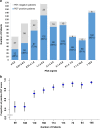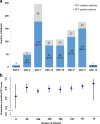Diagnostic performance of 68Ga-PSMA-11 (HBED-CC) PET/CT in patients with recurrent prostate cancer: evaluation in 1007 patients
- PMID: 28497198
- PMCID: PMC5486817
- DOI: 10.1007/s00259-017-3711-7
Diagnostic performance of 68Ga-PSMA-11 (HBED-CC) PET/CT in patients with recurrent prostate cancer: evaluation in 1007 patients
Erratum in
-
Erratum to: Diagnostic performance of 68Ga-PSMA-11 (HBED-CC) PET/CT in patients with recurrent prostate cancer: evaluation in 1007 patients.Eur J Nucl Med Mol Imaging. 2017 Sep;44(10):1781. doi: 10.1007/s00259-017-3763-8. Eur J Nucl Med Mol Imaging. 2017. PMID: 28656360 Free PMC article. No abstract available.
Abstract
Purpose: Since the clinical introduction of 68Ga-PSMA-11 PET/CT, this imaging method has rapidly spread and is now regarded as a significant step forward in the diagnosis of recurrent prostate cancer (PCa). The aim of this study was to analyse the influence of several variables with possible influence on PSMA ligand uptake in a large cohort.
Methods: We performed a retrospective analysis of 1007 consecutive patients who were scanned with 68Ga-PSMA-11 PET/CT (1 h after injection) from January 2014 to January 2017 to detect recurrent disease. Patients with untreated primary PCa or patients referred for PSMA radioligand therapy were excluded. The possible effects of different variables including PSA level and PSA doubling time (PSADT), PSA velocity (PSAVel), Gleason score (GSC, including separate analysis of GSC 7a and 7b), ongoing androgen deprivation therapy (ADT), patient age and amount of injected activity were evaluated.
Results: In 79.5% of patients at least one lesion with characteristics suggestive of recurrent PCa was detected. A pathological (positive) PET/CT scan was associated with PSA level and ADT. GSC, amount of injected activity, patient age, PSADT and PSAVel were not associated with a positive PET/CT scan in multivariate analysis.
Conclusion: 68Ga-PSMA-11 PET/CT detects tumour lesions in a high percentage of patients with recurrent PCa. Tumour detection is clearly associated with PSA level and ADT. Only a tendency for an association without statistical significance was found between higher GSC and a higher probability of a pathological PET/CT scan. No associations were found between a pathological 68Ga-PSMA-11 PET/CT scan and patient age, amount of injected activity, PSADT or PSAVel.
Keywords: PET/CT; PSMA; Positron emission tomography; Prostate cancer; Prostate-specific membrane antigen.
Conflict of interest statement
Ethical approval
All patients included in this study signed written informed consent form for anonymized evaluation and publication of their data. All reported investigations were conducted in accordance with the principles of the Declaration of Helsinki and with our national regulations (German Medicinal Products Act, AMG §13 2b). This study was approved by the ethics committee of the University of Heidelberg (S-321-2012).
Conflicts of interest
None.
Figures


References
-
- Israeli RS, Powell CT, Corr JG, Fair WR, Heston WD. Expression of the prostate-specific membrane antigen. Cancer Res. 1994;54:1807–1811. - PubMed
MeSH terms
Substances
LinkOut - more resources
Full Text Sources
Other Literature Sources
Medical
Research Materials
Miscellaneous

